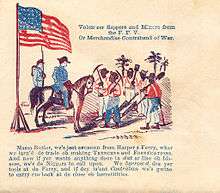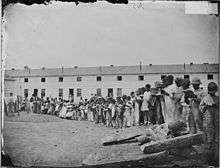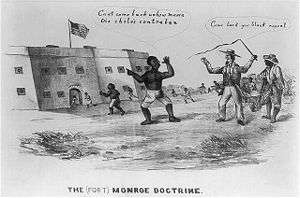Contraband (American Civil War)
Contraband was a term commonly used in the United States military during the American Civil War to describe a new status for certain escaped slaves or those who affiliated with Union forces. In August 1861, the Union Army (and the United States Congress) determined that the US would no longer return escaped slaves who went to Union lines and classified them as "contraband of war", or captured enemy property. They used many as laborers to support Union efforts and soon began to pay them wages. The former slaves set up camps near Union forces, and the Army helped support and educate both adults and children among the refugees. Thousands of men from these camps enlisted in the United States Colored Troops when recruitment started in 1863. At war's end, more than 100 contraband camps existed in the South, including the Freedmen's Colony of Roanoke Island, where 3500 former slaves worked to develop a self-sufficient community.
History

_(14589475010).jpg)
The status of Southern-owned slaves after Confederate states had engaged in the American Civil War became an issue early in 1861, not long after hostilities began. At Fort Monroe in Virginia's Hampton Roads, Major General Benjamin Butler, commander, learned that three slaves had made their way across Hampton Roads harbor from Confederate-occupied Norfolk County, and presented themselves at Union-held Fort Monroe. General Butler refused to return the escaped slaves to slaveholders who supported the Confederacy. This amounted to classifying them as "contraband," although the first use of that terminology in military records appears to have been by another officer. (see below).
The three slaves, Frank Baker, James Townsend, and Sheppard Mallory, had been leased by their masters to the Confederate Army to help construct defense batteries at Sewell's Point, across the mouth of Hampton Roads from the Union-held Fort Monroe. They escaped at night and rowed a skiff to Old Point Comfort, where they sought asylum at Fort Monroe.
Prior to the War, the owners of the slaves would have been legally entitled to request their return (as property) and likely would have done so under the federal 1850 Fugitive Slave Act. But, Virginia had declared (by secession) that it no longer was part of the United States. General Butler, who was educated as an attorney, took the position that, if Virginia considered itself a foreign power to the U.S., then he was under no obligation to return the three men; he would hold them as "contraband of war." When Confederate Major John B. Cary requested their return, Butler refused the request. Because the practice effectively recognized the seceded states as foreign entities, President Abraham Lincoln disapproved of it.
Gen. Butler did not pay the escaped slaves wages for work that they began to undertake, and he continued to refer to them as slaves. On September 25, 1861, the Secretary of the Navy Gideon Welles issued a directive to give "persons of color, commonly known as contrabands", in the employment of the Union Navy pay at the rate of $10 per month and a full day's ration.[1] Three weeks later, the Union Army followed suit, paying male "contrabands" at Fort Monroe $8 a month and females $4, and specific to that command.[2]
In August, the US Congress passed the Confiscation Act of 1861, which declared that any property used by the Confederate military, including slaves, could be confiscated by Union forces. The next March, its Act Prohibiting the Return of Slaves forbade returning slaves to Confederate masters or the military.
Grand Contraband Camp



The word spread quickly among southeastern Virginia's slave communities. While becoming a "contraband" did not mean full freedom, many slaves considered it a step in that direction. The day after Butler's decision, many more escaped slaves found their way to Fort Monroe and appealed to become contraband. As the number of former slaves grew too large to be housed inside the Fort, the contrabands erected housing outside the crowded base from the burned ruins of the City of Hampton. They called their new settlement Grand Contraband Camp (which they nicknamed "Slabtown"). By the end of the war in April 1865, less than four years later, an estimated 10,000 escaped slaves had applied to gain "contraband" status, with many living nearby. Across the South, Union forces managed more than 100 contraband camps, although not all were as large. From a camp on Roanoke Island that started in 1862, Horace James developed the Freedmen's Colony of Roanoke Island (1863–1867). Appointed by the Union Army, James was a Congregational chaplain who, with the freedmen, tried to create a self-sustaining colony at the island.[3]
Near Fort Monroe, but outside its protective walls, the pioneering teacher Mary S. Peake began to teach both adult and child contrabands to read and write. She was the first black teacher hired by the American Missionary Association, which also sent numerous Northern white teachers to the South to teach. This area of Elizabeth City County later became part of the campus of Hampton University, a historically black college. Defying a Virginia law against educating slaves, Peake and other teachers held classes outdoors under a certain large oak tree. In 1863, President Abraham Lincoln's Emancipation Proclamation was read to the contrabands and free blacks there, for which the tree was named the Emancipation Oak. For most of the contrabands, full emancipation did not take place until the Thirteenth Amendment to the United States Constitution abolishing slavery was ratified in late 1865.
Contraband term first used by William Budd
General Butler's written statements and communications with the War Department requesting guidance on the issue of fugitive slaves did not use the term "contraband."[4] As late as August 9, 1861, he used the term "slaves" for fugitives who had come to Fort Monroe.[5]
On August 10, 1861, Acting Master William Budd of the gunboat USS Resolute first used the term in an official US military record.[6] As early as 1812, the term, "contraband" was used in general language to refer to illegally smuggled goods (including slaves).[7]
Development
Contraband camps developed around many Union-held forts and encampments. In 1863, after the Emancipation Proclamation and authorization of black military units, thousands of former slaves and free blacks began to enlist in the United States Colored Troops. The Army allowed their families to take refuge at contraband camps. The black troops ultimately comprised nearly 10 percent of all the troops in the Union Army.
By the end of the war, more than 100 contraband camps had been developed in the South. Many were assisted by missionary teachers recruited from the North by the American Missionary Association and other groups who, together with free blacks and freedmen, agreed that education of the former slaves was of the highest priority. The teachers often wrote about the desire of former slaves, both adults and children, for education.
References
- Official Records of the Union and Confederate Navies in the War of the Rebellion, Series I - Volume 16, page 689.
- The War of the Rebellion: A Compilation of the Official Records of the Union and Confederate Armies, Series 2 - Volume 1, p. 774
- "The Roanoke Island Freedmen's Colony" Archived September 29, 2011, at the Wayback Machine, provided by National Park Service, at North Carolina Digital History: LEARN NC, accessed 11 November 2010
- The War of the Rebellion: A Compilation of the Official Records of the Union and Confederate Armies, Series 2 - Volume 1, page 752; Series 1 - Volume 2, page 52.
- The War of the Rebellion: a Compilation of the Official Records of the Union and Confederate Armies, Series 1 - Volume 2, page 761.
- Official Records of the Union and Confederate Navies in the War of the Rebellion, Series I - Volume 4: page 604.
- The Pirate Lafitte and the Battle of New Orleans, Robert Tallant. Random House 1951. Pelican Edition 1998 pg 65.
External links
- Documents, The Roanoke Island Freedmen's Colony - letters from missionary teachers, Horace James and freedmen available online